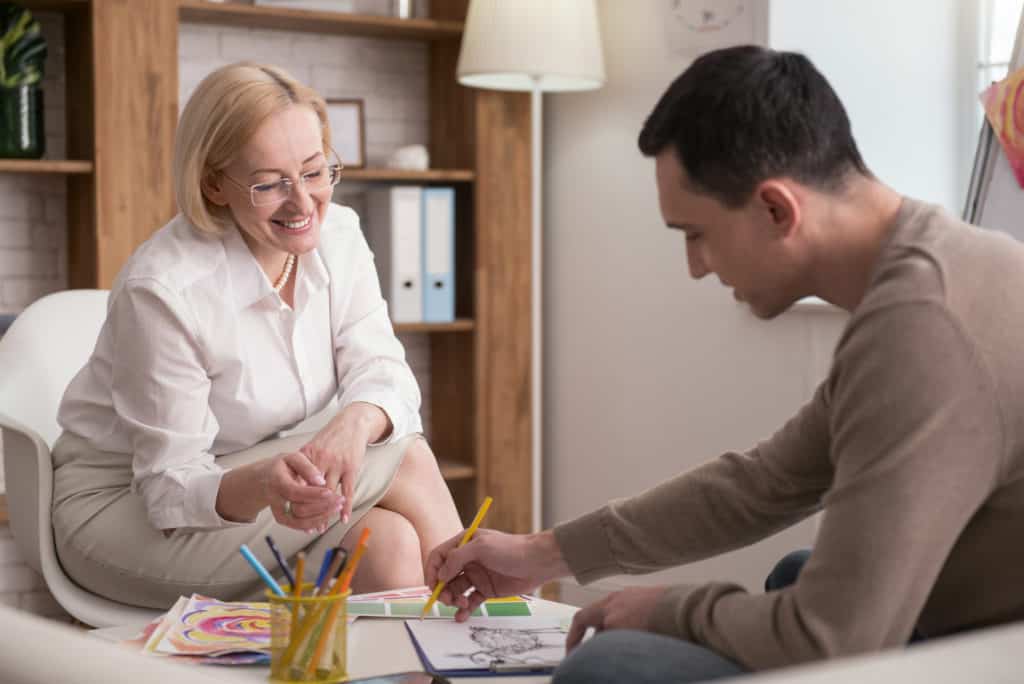This article is evidence-based, verified by Ashleigh Willis, a Neuroscience Ph.D. candidate.
People with autism spectrum disorder often find it challenging to communicate their understanding of their environment with others. As many parents and carers will know, relating to how someone with autism feels can be difficult. However, there may be a simple and effective way to help with this art therapy.
What is art therapy?
Art therapy is a form of expressive therapy or ‘psychotherapy,’ which uses the creative process of making art to improve mental well-being. Art therapy is founded on the principle that self-expression through the creative process can provide therapeutic value to anyone seeking a deeper understanding of themselves and their environment.
Treatments like these harness the emotive power of creating art to help explore emotions, manage behaviors, develop self-awareness, and improve social skills.
Children and adults with autism are visual thinkers, and art offers a natural and effective way for them to connect with their emotions, communicate how they feel or how they view the world. People with ASD can share their inner thoughts through a variety of mediums, including painting, drawing, and sculpting. This type of intervention is non-invasive and often quickly becomes a fun and exciting part of a patient’s week.
A beautiful aspect of art-therapy is how widely accessible it is. There are no pre-requisites; no previous experience of creating art is required. During therapy sessions, the focus is not on the outcome or the art produced and is instead shifted entirely onto the internal process.
Whether pen, paint, charcoal, or chalk, the treatment will dive into the underlying messages being communicated by the art created.
What does an art therapy session look like?
The types of art therapy available are diverse, but they all center on arts-based activities in a therapeutic environment. Sessions will generally be tailored to the individual and will differ, mainly depending on the age of the patient.
Art therapy for children and young people
When first implementing art therapy, practitioners suggest that the sessions take place regularly and begin in a location that is familiar to the child. Familiarity may be particularly important in fostering comfort and enabling the child to open up to the session fully.
Therapy sessions commonly take place at home or in school, but can also be based at a therapy center. For children, it is vital to building the therapy session with some structure to reap the full benefits. In general, therapists will begin with a ‘warm-up session.’ This session will be based around a small activity or exercise aimed at acclimatizing the child to their setting and the therapy session.
Following this, the trained art therapist will help guide the child through a variety of different creative activities that will be tailored to the individual. In this way, art therapy is more beneficial when sessions are frequent; this allows the therapist to understand the needs of the child truly.
For some children, it may take some time and tweaking by the therapist to find which materials and methods of creating artwork best for them. Studies have also suggested that, in children, limiting the number of materials can be beneficial in preventing any overwhelming effects of too many choices.
Finally, art therapy sessions will never end abruptly. Just as therapy sessions ‘ease in’ with a warm-up activity, therapists will build in time to ‘warm-down’ activities – letting children know how long they have left. This winding down of the session is vital in reducing anxiety, which can be caused by an abrupt end to an emotionally involved session.
Children with ASD can take part in art therapy from as young as 2 or 3 years old. In fact, in this age group, art therapy can be particularly helpful in helping them cope with the increasing complexity of the world around them.
Art therapy for adults

In people with autism, the hallmark of impairments to social, verbal, and emotional communication persist past childhood. These types of difficulties can become increasingly frustrating as people move into adulthood. As we all know, the world and our interactions within it become much more complex and hard to understand as we grow older.
So, it’s of little surprise that art therapy is beneficial to adults with autism too.
Therapy sessions with adults are based around the same principles are described before, but can be slightly altered depending on the communication level of the individual.
If you’re a caregiver of someone with autism, you’d likely be invited to join in their first session, where the therapist would aim to find out more about the person wishing to take on art therapy. During this session, the therapist might come up with ideas about what might work for the patient, and of course, the patient can communicate their ideas of what they’d like to get out of the treatment too.
Once the treatment plan has been outlined, it’s time to begin creating some work. Once the patient starts creating, there will be a period of observation by the art therapist. This observation is non-invasive. During this period, the patient is allowed to develop freely with whatever materials they prefer.
When the patient finishes a piece of artwork, or sometimes while still creating it, the therapist might ask questions about how they feel, what the work means to them, if they have any other thoughts while working.
For both adults and children, these sessions can either be one-on-one or can be implemented in a group setting. In particular, family-based art therapies are beneficial in helping with symptoms of autism, but also with easing anxiety and stress felt by family members.
How can art therapy help someone with autism?

In terms of the reports and testimonials shared by people with autism and their families, there’s no doubt that art therapy can provide incredible benefits.
In both children and adults, self and family reports indicate that art therapy acts as an alternative form of communication, helps with social skills, and aids with sensory processing difficulties experienced by patients.
While there is a great deal of qualitative evidence which provides support to the positive outcomes of this therapy, the science is yet to catch up. Unfortunately, the pool of peer-reviewed psychological, developmental, and neuroscientific research is still quite low.
Often, these studies only include a few people or implement art therapies in vastly different ways, which makes it difficult to compare and draw any real conclusions. However, some researchers have found evidence supporting the benefits of art therapy.
So here is what the science says:
- Art therapy can improve communication skills, in particular, when this is implemented in a group-based way.
- Art therapy can benefit fine motor skills and co-ordination. These therapies may also bring about some improvements to repetitive behaviors in people with autism.
- In adults, consistent art therapy sessions provide small benefits to adaptive behaviors that enhance ‘behavioral repertoires,’ such as activities of daily living and daily communication.
- In general, adults experience the most significant overall benefits of art therapy, particularly seeing improvements in social behavior.
- The effects of art therapy are highly dependent on how it is implemented; things like frequency, time of sessions, and setting (home-based vs. center-based) are essential factors in finding success with art therapy.
Who can deliver art therapy?
If you’re a caregiver and would like to introduce a person with autism to art therapy, it’s important to know what to look for. First off, who are art therapists?
Qualified art therapists will hold a university undergraduate degree and a master’s degree in art therapy. Their training provides them with a deep knowledge of psychology, development, education and – of course, art!
Generally, art therapists will be skilled in working with multiple artistic mediums; skillsets can range from clay molding and painting to charcoal sketching and jewelry making.
Art therapist credentials will vary from country to country, but therapists will generally be registered with an official body who oversees high standards of practice and care.
In the USA, the American Art Association sets the minimum standards for art therapists, and the master’s degree of the therapist has to come from an institution that has been approved by the Council for Higher Education.
In the UK, all practicing art therapy qualifications must be approved by the Health and Care Professions council.
Choosing the right therapist
While credentials are important, finding the right art therapist for a child or adult with autism is about more than qualifications on paper. One of the most important things to do when deciding on an art therapist is to meet with them to discuss their experience. It’s a good sign if the therapist works with people with autism a lot, as it’s likely they’ll have a good deal of specialized knowledge.
For almost all therapeutic interventions, traditional and non-traditional, research links the most successful outcome to an individualized experience and good patient-therapist rapport.
As a caregiver, meeting with the therapist and knowing their background can give you a good idea about whether they are the right practitioner for you.
A common theme we keep returning to is the importance of an individualized treatment plan. When embarking on art therapy, make sure you find a therapist with a track record of working with a wide variety of materials. It’s also a good idea to discuss what kinds of therapies they can offer, how frequently and for how long.
Research highlights that consistency may be key in reaping the benefits of art therapy. Make sure you’re both able to commit to a long-term therapy program before embarking on the journey.
Click here to read about Equine Therapy for Children with Autism

Ashleigh Willis is a final year Ph.D. candidate in Neuroscience at the University of Glasgow. Her research investigates the genetic and environmental contributors to mental health and neurodevelopmental conditions. Ashleigh has built research collaborations with McGill University and received specialist training at the Centre for Neuroscience at Montreal General Hospital, McGill University Health Centre. She is also an active member of the Society for Neuroscience. Ashleigh holds an Honours in Psychology, an MRes in Neuroscience and is fascinated by the neuronal circuits which make us who we are. Ashleigh is passionate about providing a deeper understanding of mental health conditions and sharing an accurate and de-stigmatizing message through talks for organizations such as TEDx, Pint of Science and the Scottish Funding Council.
You can follow Ashleigh on her Youtube channel here
References
- [1] Javier Virues-Ortega, Flávia M. Julio, Roberto Pastor-Barriuso (2013). The TEACCH program for children and adults with autism: A meta-analysis of intervention studies. Clinical Psychology Review. 33, 8, 940-953. https://doi.org/10.1016/j.cpr.2013.07.005
- [2] Martin N. Art therapy and autism: overview and recommendations. Art Ther. 2009;26(4):187–190. doi:0.1080/07421656.2009.10129616.
- [3] McGovern M, Byrne A, McCormack M, Mulligan A (2016) The Vasarhelyi Method of Child Art Psychotherapy in Child and Adolescent Mental Health Services: a stakeholder survey of clinical supervisors. Ir J Psychol Med 1–8. doi:10.1017/ipm.2016.29
- [4] Schweizer C, Knorth EJ, Spreen M. Art therapy with children with autism spectrum disorders: a review of clinical case descriptions on ‘what works’ Arts Psychother. 2014;41(5):577–593. doi:10.1016/j.aip.2014.10.009.
- [5] Mathew Chiang, William Bernard Reid-Varley, Xiaoduo Fan. (2019). Creative art therapy for mental illness. Psychiatry Research. 275, 129-136. https://doi.org/10.1016/j.psychres.2019.03.025
 .
. - [6] American Art Therapy Association (2009). About Art Therapy. Available from: http://www.arttherapy.org/aboutart.html
 .
. - [7] Case C, Dalley T. (2008). Art Therapy with Children from Infancy to Adolescence. USA: Routledge

